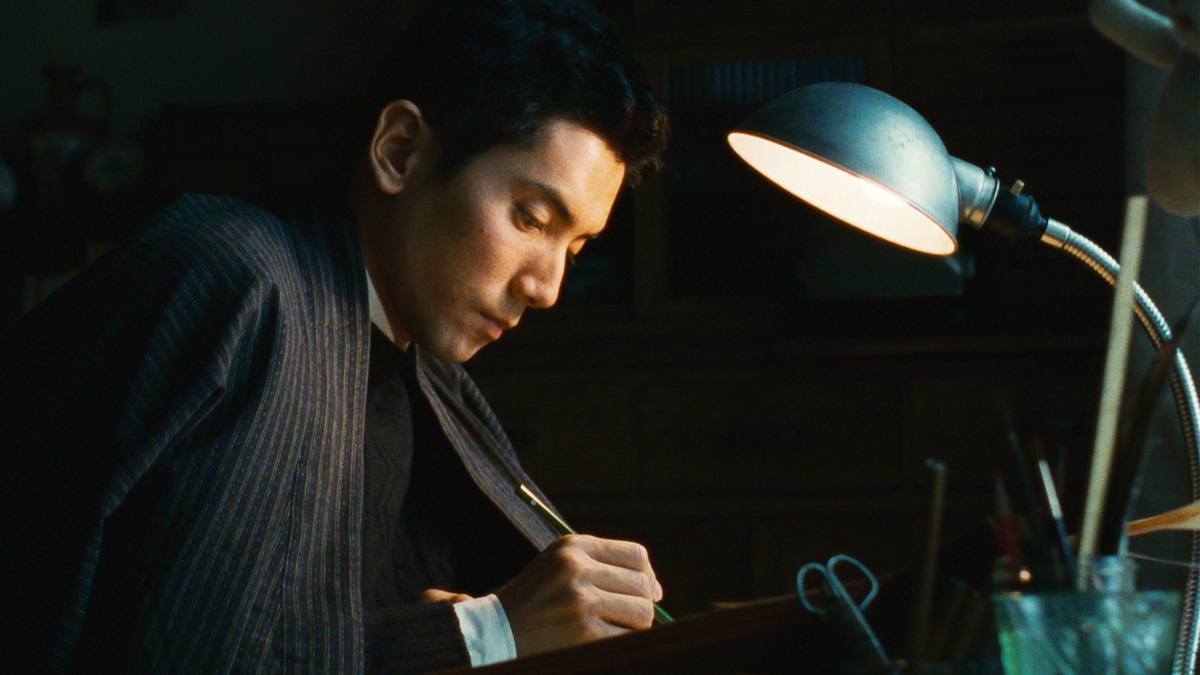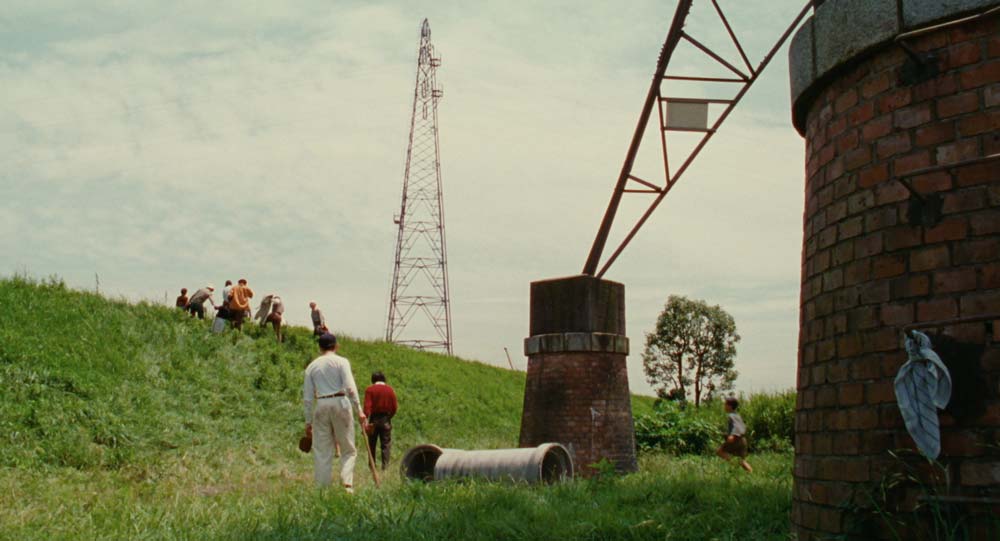
©1995/2020 Culture Entertainment Co., Ltd
"Tokiwa-so's Youth" The light and shadow of young manga artists drawn in the legendary apartment (Part 2/Photography part)
2021.02.13
Simple methods and locations that recreate the 1950s
The reason why it's difficult to make movies set in the past is because even if you can manage to create interiors with sets, it's almost impossible to show a wide range of cityscapes. You can also use miniatures, but this is also difficult if you don't have a budget. Using VFX, it would be possible to recreate the movie on a scale like the “ Always Sunset on 3rd Street ” series (2005-2012), which was set in a time similar to “Tokiwa-so's Youth-sou”, but this work was made That was not the case in the mid-1990s. It was around the time that CG was finally starting to be used in earnest in Hollywood blockbusters, and in Japanese movies, it was okay to use only a few cuts in a major movie.
Director Juzo Itami, one of the few hit makers in the Japanese film industry at the time, was also planning a film set around 1955. Let's make a movie of `` Inspector Sasa Patrol Diary: Meguro Police Station Story '' (Author: Atsuyuki Sasa/Bunshun Bunko), which was written by Atsuyuki Sasa, the former head of the Cabinet Security Office in the Cabinet Secretariat, who was in charge of the Asama Sanso Incident, based on his own experiences. This is the story of a rookie police officer who took his first steps at Meguro Police Station in 1952 with this idea. 1954 coincides with the time when Fujiko Fujio moved into Tokiwa-sou, but unfortunately the film adaptation was cancelled. The only way to recreate the townscape of this era was to create a grand open set, and even with hit maker Itami, this was impossible.
As a side note, Jun Ichikawa and Juzo Itami have similar circumstances. Before making movies, he was involved in the production of commercials (Itami was not only an actor, but also an essayist, commercial, and TV documentary producer), and it is common that the unusual content of the commercial attracted a lot of attention. .
If you only compare the films they directed, it may seem like the two have contrasting styles, but they actually have a lot in common. For example, Itami came up with the idea for `` The Great Sick '' (1993) after reading the bestseller `` What It Means to Die in a Hospital, '' which deals with end-of-life care, and had intended to make it into an original story, but Ichikawa had already made it into a movie. Since it was so advanced, I only used it as a reference.
Ichikawa, who had carefully watched plays performed by small theater companies, also paid attention to Koki Mitani from an early stage, and later produced a film version of `` Ryoma's Wife, Her Husband and Mistress '' (2002), which he himself planned, but Itami also admired Mitani. He noticed Mitani's talent from an early stage, and even had Mitani write the script that became the basis for `` The Maltese Woman '' (1997).
Regarding ``Sunset on 3rd Street,'' mentioned at the beginning, Ichikawa had planned a live-action adaptation starring Ken Shimura long before Takashi Yamazaki made it into a movie, so Juzo Itami and Jun Ichikawa worked together to make it into a movie. , the fact that they were planning a movie around 1955 is very interesting.
“Always Sunset on Third Street” preview
Returning to ``Tokiwa-so's Youth,'' Ichikawa used photography and song to recreate the 1950s.
Throughout the film, photos taken by Ihei Kimura and Takeyoshi Tanuma of Tokyo at the time are inserted throughout the film (most of them are Kimura's photos). All of the photographs, from distant views of the city to children playing in back alleys, give off a sense of the times, and Ichikawa used them in François Truffaut's `` Suddenly on Fire '' (62), which was filmed on a newsreel. This method was used after remembering that it had been inserted, and ``I didn't put it in as a last resort, but rather in a more proactive way.'' (Kinema Junpo (early April 1996 issue)) However, it is said that there was a lot of opposition from those around him until the very end, perhaps because they thought that using too many photographs would stop the flow of the movie.When you actually watch the movie, each photo adds to the worldview of the movie. You should see that it has the effect of spreading the word.
Another thing that leaves a deep impression is the songs. The program begins with Noboru Kirishima's `` Pendulum of the Heart, '' followed by Katsuhiko Haida's melodies such as ``Shinmeku Constellation '' and ``Under the Roof of Tokyo .'' However, these songs were not the latest popular songs of the time. ``Chest Pendulum'' was written in 1947, and ``Under the Roofs of Tokyo'' was written in 1948. There is a gap of 7-8 years from the era in which the story is set, but compared to the ease with which `` Ringo no Uta '' plays as if stamped on a stamp to express the period immediately after the war, it is a far cry from the people of the time. This work, which has a selection of familiar and familiar songs, perfectly embodies the idea that ``songs change with the times, and the times change with the songs.''
However, he did not rely solely on photography and singing. Don't miss the fact that he captures the faint traces of Tokyo from those days, little by little, and reflects them on screen. Let's take a look at the main filming locations.
The long, unpopular staircase that repeatedly appears symbolically is Koshinzaka in Bunkyo Ward. The Marunouchi Line runs above the guard leading to the back, but the frame is cleverly cut to prevent the train from entering the screen.

“Tokiwa-so's Youth” ©1995/2020 Culture Entertainment Co., Ltd
The editorial department of Gakudosha, which published Manga Shonen, was located on the site of the Fisheries Research Institute in Kachidoki. The Shokuryo Building in Koto Ward was photographed to resemble Houbunsha's editorial department. In both cases, the art is wonderful, creating the atmosphere of a chaotic editorial department. Modern architecture like this, which miraculously survived the bubble era until the mid-1990s, has now disappeared without a trace.
The coffee shop where Hiroo Terada and Fujio Akatsuka talked was Pure Cafe Eden in Waseda University. The restaurant where Tsuge Yoshiharu and Akatsuka ate was a popular restaurant located in Asakusa's Five-storied Pagoda shopping street. The scene in which Terada visits his manga artist friend Teruo Tanashita's room takes place on the second floor of Muto, a Japanese restaurant in Ginza that opened in 1953 (it has now been rebuilt and renamed Muto Japanese Cuisine).
The riverbed where Terada plays baseball with his friends is the Tamagawa riverbed in Unane 2-chome, Setagaya-ku. There is a steel tower here whose foundation is made of brick.
He searches for places in Tokyo that still have a slight vestige of the 1950s, and creates an atmosphere of the era by layering photographs, songs, and meticulously detailed sets. ``Tokiwa-so's Youth'' is also the last work of the era where you can feel the unique taste of movies using analog methods.
Wonderful casting that combines Masahiro Motoki with a small theater actor

